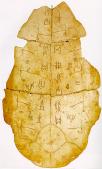|
~~Shang Dynasty (1600
BC - 1046 BC) is the first historic Chinese dynasty and ruled in
the northeastern region of China proper. The Shang dynasty followed
the legendary Xia Dynasty and preceded the Zhou Dynasty (1122 BC
- 256 BC). Information about the Shang Dynasty comes from bronze
artifacts and oracle bones, were turtle shells or cattle scapula
on which were written the first recorded Chinese characters, found
in the Huang He valley. These bones typically had three sections:
a question for the oracle (charge), the oracle's answer (prognostication),
and whether the oracle later proved to be correct (Verification).
The bones are often from cattle, oxen or monkeys, but never from
cats or dogs.
The Yin(latter half of Shang) left written historic records containing
information on the politics, economy, culture, religion, geography,
astronomy, calendar, art and medicine of the period, and as such
provides critical insight toward the early stages of the Chinese
civilization. The site of the Yin capital, later historically called
the Ruins of Yin ,is near modern day Anyang Archaeological work
there uncovered 11 major Yin royal tombs and the foundations of
palace and ritual sites, all of them  containing
weapons of war. Tens of thousands of bronze, jade, stone, bone and
ceramic artifacts have been obtained; the workmanship on the bronzes
attests to a high level of civilization. In terms of inscribed oracle
bones alone, more than 20,000 were discovered. Many Chinese characters
found in the inscriptions at the Ruins of Yin are still in use today. containing
weapons of war. Tens of thousands of bronze, jade, stone, bone and
ceramic artifacts have been obtained; the workmanship on the bronzes
attests to a high level of civilization. In terms of inscribed oracle
bones alone, more than 20,000 were discovered. Many Chinese characters
found in the inscriptions at the Ruins of Yin are still in use today.
The Shang dynasty is believed to have been founded by a rebel leader
who overthrew the last (still legendary) Xia ruler. Its civilization
was based on agriculture, augmented by hunting and animal husbandry.
The Records of the Grand Historian states that the Shang Dynasty
moved its capital six times. The final and most important move to
Yin in 1350 BC led to the golden age of the dynasty. The term Yin
Dynasty has been synonymous with the Shang dynasty in history, although
lately it has been used specifically in reference to the latter
half of the Shang.
A line of hereditary Shang kings ruled over much of northern China,
and Shang troops fought frequent wars with neighboring settlements
and nomadic herdsmen from the inner Asian steppes. The capitals,
particularly in Yin, were centers of glittering court life. Court
rituals to propitiate spirits and to honor sacred ancestors were
highly developed. In addition to his secular position, the king
was the head of the ancestor- and spirit-worship cult. Evidence
from the royal tombs indicates that royal personages were buried
with articles of value, presumably for use in the afterlife. Perhaps
for the same reason, hundreds of commoners, who may have been slaves,
were buried alive with the royal corpse.
Shang Zhou, the last Yin king, committed suicide after his army was
defeated by the Zhou people. Legends say that his army betrayed him
by joining the Zhou rebels in a decisive battle. A classical novel
Fengshen Yanyi is about the war between that of Yin and Zhou, in which
each was supported by one group of gods.
After the Yin's collapse, the surviving Yin ruling family collectively
changed their surname from their royal Ó (pinyin: zi; Wade-Giles:
tzu) to the name of their fallen dynasty, Yin ó. The family
remained aristocratic and often provided needed administrative services
to the succeeding Zhou Dynasty. The Zhou King Cheng ÜÉõ
through the Regent, his uncle the Duke of Zhou Dan , enfeoffed the
Shang King Zhou's brother the Viscount of Wei, WeiZi ¢Ó
in the old Shang capital at Shang Ì with the territory becoming
the state of Song Î. The State of Song and the royal Shang
descendants maintained rites to the dead Shang kings and lasted
until 286BC. (Source: Records of the Grand Historian).
Both Korean and Chinese legends state that a disgruntled Yin prince
named þÓ Jizi (Kija), who refused to cede power to
the Zhou, left China with his garrison and founded Gija Joseon near
modern day Pyongyang to what would become one of the early Korean
states (Go-, Gija-, and Wiman-Joseon). Though Jizi is mentioned
only a few times in Shiji, it is thought that the story of his going
to Joseon is but a myth.
|

